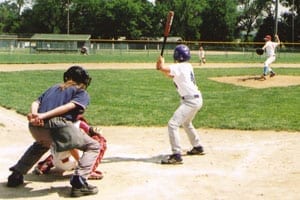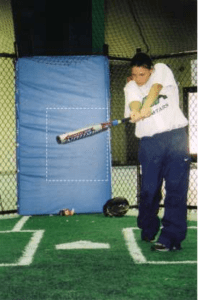Plate Umpire Aims for the Zen Strike Zone
Heads up
Plate umpire aims for the Zen Strike Zone. The Zen Strike Zone? Players, coaches, fans know what pitch will be called a strike. Coaches prefer a wide zone.
The Down and Get Dirty (TD&GD):
The younger the players, the wider the zone.
Goal? Wide strike zone: You want the batter swinging the bat. Not only does the game move faster but everyone in the yard is involved.
Think, bases loaded, no out, go-ahead run at the plate. Players, coaches and fans are at edge of their seat. Moments are tense, action-packed.
You have a wild pitch or a passed ball. Difference? Wild pitch: The pitcher has no chance at making the catch. Passed ball: Pitch gets by the catcher.
TD&GD:
OBR (Official Baseball Rules) Definition: the STRIKE ZONE is that area over home plate the upper limit that is horizontal at the midpoint between the top of the shoulders and the top of the uniform pants, and the lower level is at the hollow beneath the knee cap. The Strike Zone will be determined from the batter’s stance as the batter is prepared to swing to swing at a pitched ball.

Heads Up
Battery check.
Pregame
You might want to get behind the catcher and watch pitcher’s warm-up tosses. This gives you an idea of a critical element, his control. In a word, battery skill level.
You also get good idea of the catcher’s skill level. How many wild pitches/passed balls get by him.
Heads Up
Crew check
Good time to go over coverage areas with your partner. U2 says, “I’ve got fly balls to cf with no out.” U1 will say, “OK, I’ve got the runner.”
TDGD ball stays live when pitch gets behind the catcher.
TDGD any contact with the bat, ball in foul territory, we have the DEAD BALL. No runners advance. Ball is LIVE again when the pitcher has the ball.
I. Watching the infielders warm up, you and your partner make a skill-level assessment.
- Infield: Check out catching the ball, throwing accuracy.
- Outfield: Check catching and throwing accuracy.
II. Setting up at the plate.
- HOK (hands on knees) set.
- Batter steps in.
- Pitcher steps on rubber.
- When pitcher releases, crouch down—head just above the catcher’s shoulders.
Get your comfort zone. Mask, chest protector, shin guards, hard-soled shoes. This is key. Plate mechanics are easy to learn—they are repetitive. Muscle memory kicks in.

Above: This is the DLR (Dotted Line Rectangle).
TIP: Watch MLB plate umpires:
How they set up.
How they call the pitch.
What they do on the batted ball.
You can perfect your own plate technique by watching the pro’s.
III. Calling the first pitch.
- Keep your eye on pitcher’s glove.
- Follow the pitch from release to the catcher.
- Hear the smack of the ball in the catcher’s glove.
- Ask yourself, “Was that a strike or a ball?”
IV. Strike call. Throw the “hammer” with the right hand.
- If in DLR, pitch is a strike.
- If batter does not swing, say “Strike.”
- If batter swings and misses, throw the hammer.
- This is like you’re pounding on the door of a house with your right hand.
- If “cuts” DLR, pitch is a strike.
- If pitch is outside DLR, it is a ball. (The DLR is like a hunk of cheese, ask yourself “Did the pitch cut the cheese?”)
V. Say “Strike” loud enough for fans to hear.
- Throw the hammer.
VI. Pitch outside DLR.
- Track the pitch from release to hitting the catcher’s mitt.
- Ask yourself, was that a ball or a strike? Make the call.
- Say “ball” loud enough for dugouts to hear.
VII. Calling the pitches.
- Strike call, move the indicator.
- 0-1 is the count.
- Ball call, move the indicator.
- 1-1 is the count.
- Strike call, move the indicator.
- 1-2 is the count.
- Because youth ball diamonds do not have a scoreboard, you have to say and display.
- You yell, “The count is 1 ball and 2 strikes.”
- Now, while there is pressure on the hitter to swing, stay focused. call the strike if the pitch hits the DLR.
VIII. The “K” or Strike Out.
- Say, “Strike three, you’re out.”
IX. Strike three and you’re not out.
- Catcher does not catch the ball or dropped third strike.
- Batter is now a runner. He can run to 1B.
- This is U1’s call.
- Follow the catcher.
- Let the throw take you to the play.
- Make the safe/out call at 1B.
X. TDGD Strikes and outs get you home.
I. On the 2-2 count, the batter connects.
II. GB to ss.
III. U1 clears the catcher, sets up to watch the BR (Batter-runner) head for 1B.
IV. U1 backs up U2 in case the ball gets by the 1B
V. Makes the call if it goes in the dugout or out of play.
VI. We have a “dead ball” situation.
VII. BR is awarded and extra base—he is now at 3B.
I. The foul ball is U1’s responsibility to 1B with no runners on up to 1B.
- U2 is in the A position. If the ball is hit beyond 1B bag, he makes the foul/fair call.
II. The foul ball up and down the 1st base and 3rd base line is U1’s responsibility if U2 is B or C Position.
III. Mechanics, Foul Ball.
- High FL (Frequency Level): U1 throws his hands in the air and yells, “Foul Ball out of play” Or, if not out of play, yells “Foul ball.”
- Medium FL: U2 runs down the 1B line and yells, “Foul Ball out of play”
- Medium FL: U2, runs down
IV. Mechanics, Fair Ball.
- High FL: Line drive down the line.
- Try to straddle. This can be tough if the white line doesn’t go to the fence.
- If fair, simply point fair.
- I saw how ML Umpire makes chopping gestures, designating “Fair ball."
i. When there are runners on, the Blue Crew, U1 and U2, have fly ball coverage in the V.
ii. U2 has those fly balls hit-roughly between ss and 2B.
- This is a V.
iii. U1 has fly ball coverage outside the V.
Heads up
This is where umpire communication comes in handy: U1 will say, “Bill, I got the fly ball.” Bill will say, “I got the runner.”
F. Fly Ball coverage with no outs.
G. U1 has balls hit from center field through left field to the line.
H. U2 has balls from center field through right field to the line.
- He will yell, “Bill, I’m going out.”
- Jerry will yell, “I’ve got the runner.”
I. Plays you’ll have to get used to.
- Play at the plate (HF).
- Best is to stand back, let the play develop.
- Work to get the angle.
- Throws from left field, get the 90 degree angle by going to right field.
- Throws from right field, get the 90 degree angle.
J. Passed ball (catcher’s error); wild pitch (pitcher’s error) (HF).
- Keep an eye on what the catcher does.
- Keep your eye on the ball.
- Let the throw take you to the play.
- Always, take your time on the call.
- Point then make the call, safe or out.
K. Foul ball near the plate.
- Get out of the way of the catcher.
- Follow him as he tries to make the catch.
- Catch/no catch; safe out.
- Keep your eye on the catcher. If he’s not doing anything, neither are you.
L. Bunt/squib hit (LF/MF).
- This will be a close play at 1B.
- Clear the catcher, make sure the ball is picked up in fair territory.
- If fair, make the signal.
- If foul, yell foul ball, throw your hands up above your head.
M. Line drive down the line (HF).
- Try to get out, track the ball.
- See if it lands in fair/foul territory.
- Make the call, safe or out, soon as you know.
N. Trouble balls…not routine, no easily fielded.
- Looping fair/foul ball down the line.
- Tough chance anywhere.
- Above the outfielder’s head.
- Hit to the fence.
- Two or three players converging on the fly ball.
- Two or three players converging on squib hit/slow roller/bunt.
Trouble balls rank right up there with the toughest calls to make, the ones you have to work extra hard to cover, to get the call right. Let’s look at the first part of these trouble calls—fair/foul and catch/no catch.
O. More definitions form the OBR.
- A FLY BALL is a batted ball that goes high in the air in fight.
- A FORCE PLAY is a play in which the batter legally loses his right to occupy a base by reason of the batter becoming a runner.
- A GROUND BALL is a batted ball that rolls or bounces close to the ground.
- LEGAL is in accordance with the rules.
- A LINE DRIVE is a batted ball that goes sharp and direct from the bat to a fielder without touching the ground.
- “PLAY” is the umpire’s order to start the game or resume action following any dead ball.
- A RETOUCH is the act of a runner in returning to a base as legally required.
Like field diagrams and signals, becoming familiar with key terms helps us with diamond language. This means calls are made with clarity and confidence: Samples - Signals are correct.

Signals to partner.
Time signal to partner. Dead ball, delayed dead ball.
Batter interference.
Catcher interference (glove hits bat…go the 1B).
Interference/obstruction.
Understanding rules to game application.
Meeting with coaches, complaining about a call: keep it short. Stand next to home plate. Call play. Skip has two choices. Go to the dugout or get tossed.